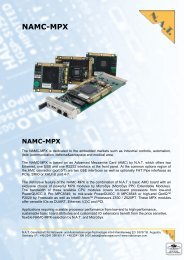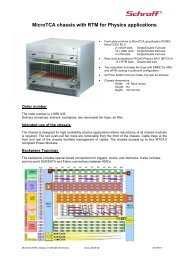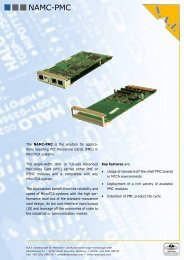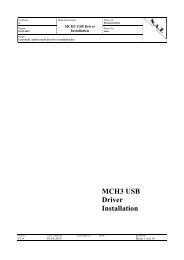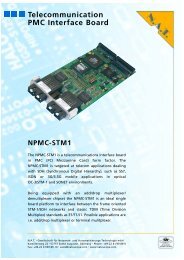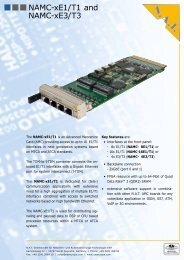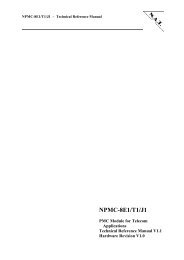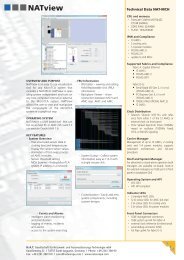NAMC-8569-CPU - NAT
NAMC-8569-CPU - NAT
NAMC-8569-CPU - NAT
You also want an ePaper? Increase the reach of your titles
YUMPU automatically turns print PDFs into web optimized ePapers that Google loves.
<strong>NAMC</strong>-<strong>8569</strong>-<strong>CPU</strong><br />
The <strong>NAMC</strong>-<strong>8569</strong>-<strong>CPU</strong> is a multi-service <strong>CPU</strong><br />
board in Advanced Mezzanine Card (AMC)<br />
form factor:<br />
• Latest Freescale PowerQUICC ® III MPC<strong>8569</strong><br />
processor<br />
− dual Multichannel Communication<br />
Controller (MCC)<br />
− higher core frequency than predecessor<br />
PowerQUICC III processors<br />
• DDR2 SDRAM 1GB, NAND-Flash 2GB<br />
• Lattice FPGA<br />
− up to 70.000 logic cells<br />
• Interfaces at front panel<br />
− 2x Gigabit Ethernet (GbE)<br />
− USB port and RS232<br />
− optional user defined IO via sub module<br />
− optional TDM connectivity<br />
• Backplane connections<br />
− 2x Gigabit Ethernet (GbE)<br />
− Serial Rapid IO (SRIO)<br />
− PCI Express ® (PCIe)<br />
N.A.T. Gesellschaft für Netzwerk- und Automatisierungs-Technologie mbH<br />
Kamillenweg 22 l 53757 Sankt Augustin, Germany l Phone: +49 2241 3989 0<br />
Fax: +49 2241 3989 10 l sales@nateurope.com l www.nateurope.com<br />
• TDM and I-TDM<br />
− 125 µs and 1 ms I-TDM modes as<br />
well as TDM cross-connect supported<br />
• customizeable I/O mezzanines<br />
Flexibility, high-bandwidth and low latency processing<br />
dedicate the <strong>NAMC</strong>-<strong>8569</strong>-<strong>CPU</strong> for applications<br />
in (tele-)communication, medical,<br />
industrial automation, defense&aerospace and<br />
telecommunication market.<br />
One or both GbE interfaces can be switched<br />
or multiplexed towards the <strong>CPU</strong> and the backplane.<br />
Depending on the required throughput one Fat<br />
Pipe (PCIe or SRIO) or the combination of both<br />
Fat Pipes (PCIe and SRIO) is available to the<br />
backplane. Thus, the <strong>NAMC</strong>-<strong>8569</strong>-<strong>CPU</strong> is targeting<br />
at applications where IO boards need<br />
PCIe and where low latency of SRIO for multiprocessing<br />
is requested.
N.A.T. and the N.A.T. logo are registered Trademarks of N.A.T. GmbH, Germany.<br />
All other brands or names are property of their respective holders. (11IS04)<br />
Technical Data<br />
<strong>NAMC</strong>-<strong>8569</strong>-<strong>CPU</strong><br />
Overview and Purpose<br />
The <strong>NAMC</strong>-<strong>8569</strong>-<strong>CPU</strong> is a multi-service<br />
processor board featuring multiple Ethernet,<br />
SRIO, PCIe interfaces along with<br />
an USB port and optional TDM connectivity.<br />
It is available as a single compact-,<br />
mid- and full-size AMC. The full-size AMC<br />
can be equipped with an extension board<br />
adding customized I/O functionality. The<br />
<strong>NAMC</strong>-<strong>8569</strong>-<strong>CPU</strong> provides flexibility,<br />
high-bandwidth and low latency processing<br />
in next generation systems based on<br />
the MicroTCA ® or ATCA standards.<br />
The combination of software based<br />
processing resources and FPGA based<br />
hardware resources dedicate the <strong>NAMC</strong>-<br />
<strong>8569</strong>-<strong>CPU</strong> for a wide-spread of possible<br />
applications in (tele-)communication,<br />
medical, industrial automation,<br />
defense&aerospace and telecommunication<br />
market.<br />
<strong>CPU</strong> and Memory<br />
The <strong>NAMC</strong>-<strong>8569</strong>-<strong>CPU</strong> is equipped with<br />
the powerful Freescale PowerQUICC III<br />
MPC<strong>8569</strong>. It offers an e500 PowerPC core<br />
combined with dedicated interface hardware<br />
and four RISC cores. This network<br />
processor operates at core frequencies of<br />
800, 1000 or 1333 MHz. The main onboard<br />
memory is delivered by 128-1024<br />
MB DDR2 SDRAM. In addition, the <strong>NAMC</strong>-<br />
<strong>8569</strong>-<strong>CPU</strong> is equipped with 16-128 MB 16bit<br />
parallel FLASH (NOR) and 2GB NAND<br />
Flash memory. A Micro-SD-Card slot<br />
could be used for high capacity, non-volatile<br />
but removable memory. Permanent<br />
write capabilities i.e. for data capturing<br />
are provided by an optional 512 kB MRAM<br />
(non-volatile SRAM).<br />
Front Panel Interfaces<br />
The flexible deployment of the <strong>NAMC</strong>-<br />
<strong>8569</strong>-<strong>CPU</strong> is based on the rich offer of<br />
versatile interfaces. For example, the<br />
USB trunk can be applied either to implement<br />
USB host or device functionality.<br />
The RS232 serves for debugging purpose<br />
along with a standard terminal program.<br />
Both GbE interfaces are directly connected<br />
to the FPGA from Lattice and can be<br />
operated via back plane or front panel, or<br />
in a combination of both.<br />
TDM and I-TDM Interface<br />
The ECP3 FPGA from Lattice provides<br />
the powerful TDM to I-TDM bridge to the<br />
<strong>NAMC</strong>-<strong>8569</strong>-<strong>CPU</strong> along with a timeslot interchanger<br />
(TSI) that is also implemented<br />
in the FPGA logic. Line interfaces of other<br />
AMC boards can be directly connected to<br />
channels of the MPC<strong>8569</strong> MCC controllers<br />
allowing flexible routing. The TDM-to-I-<br />
TDM bridge converts the TDM oriented<br />
bit stream into Ethernet packets and vice<br />
versa. In addition to the I-TDM interface,<br />
the TSI offers an optional 32 MHz clocked<br />
H.110-alike TDM backplane interface at<br />
the AMC connector (extended area).<br />
Fabric Support<br />
Fat Pipe<br />
The <strong>NAMC</strong>-<strong>8569</strong>-<strong>CPU</strong> offers four bidirectional<br />
serial lanes that can be operated<br />
either as PCIe, SRIO, or a combination of<br />
both.<br />
The <strong>NAMC</strong>-<strong>8569</strong>-<strong>CPU</strong> can be configured to<br />
implement either<br />
PCIe: one x1 (port 4/8) or<br />
one x4 (ports 4-7/8-11).<br />
SRIO: two x1 (port 4 and 8) or<br />
one x4 (port 4-7/8-11).<br />
The speed is configurable for 1.25 Gb/s,<br />
2.5 Gb/s or 3.125 Gb/s.<br />
PCIe and SRIO: one x1 PCIe (port 4) and<br />
one SRIO (port 8).<br />
In this case the speed of the SRIO interface<br />
is fixed at 2.5 Gb/s<br />
Base Fabric<br />
The <strong>NAMC</strong>-<strong>8569</strong>-<strong>CPU</strong> provides two<br />
1000BaseX interfaces at port 0 and port 1<br />
of the common options region of the AMC<br />
backplane connector.<br />
N.A.T. Gesellschaft für Netzwerk- und Automatisierungs-Technologie mbH<br />
Kamillenweg 22 l 53757 Sankt Augustin, Germany l Phone: +49 2241 3989 0<br />
Fax: +49 2241 3989 10 l sales@nateurope.com l www.nateurope.com<br />
Technical Data<br />
System Processor and Memory<br />
• up to 1,3 GHz Freescale Power<br />
QUICCIII MPC<strong>8569</strong><br />
• 128-1024 MB DDR2 SDRAM<br />
• 16-128 MB FLASH<br />
• Micro-SD-Card slot<br />
• 512 kB MRAM<br />
• 2 GB NAND Flash<br />
Front Panel Interfaces<br />
• USB, RS232, 2 x GbE<br />
Backplane Connectivity<br />
Fat Pipe Interface Options<br />
• PCIe x4 on ports 4-7 or 8-11<br />
• PCIe x1 on port 4 or 8<br />
• SRIO x4 on ports 4-7 or 8-11;<br />
speed 1.25Gb/s or 2.5Gb/s or<br />
3.125 Gb/s per lane<br />
• SRIO x1 on ports 4 and port 8;<br />
speed 1.25Gb/s or 2.5Gb/s or<br />
3.125 Gb/s<br />
• PCIe x1 on port 4 and SRIO x1<br />
on port 8; speed 2.5Gb/s<br />
I-TDM Interface<br />
• 1024 bidirect. 64 kbit/s channels<br />
• 125 µs-mode and 1ms-mode<br />
support<br />
TDM (optional)<br />
• H.110 alike 32MHz clocked TDM<br />
interface connects to ports 12,<br />
13 (data) and port 14 (sync)<br />
Networking<br />
• 2 x 1 GbE at AMC port 0 and 1<br />
• 2 x 1000/100/10 Base T at front panel<br />
Indicator LEDs<br />
• Various link indications by 4<br />
LED’s at RJ45 connector<br />
• 1 fault indication LED controlled<br />
by the IPMI controller<br />
• 1 general purpose LED controlled<br />
by the FPGA/<strong>CPU</strong><br />
Operating System Support<br />
• OK-1, QNX, LINUX<br />
Power Consumption<br />
• 12 V, 2A max.<br />
Environmental Conditions<br />
• operating temp.: 0°C to +55°C<br />
with forced cooling<br />
• storage temp.: -40°C to +85°C<br />
• relative humidity: 10% to 90%<br />
rh noncondensing<br />
Standard Compliance<br />
• PICMG AMC.0 Rev. 2.0<br />
• PICMG AMC.1 Rev. 1.0<br />
• PICMG AMC.2 Rev. 1.0 (Type E2)<br />
• PCIe Base Spec. Rev. 1.1<br />
• PICMG SFP.0 Rev. 1.0<br />
• PICMG SFP.1 Rev. 1.0<br />
• IPMI Specification v2.0 Rev. 1.0<br />
• PICMG µTCA.0 Rev. 1.0




